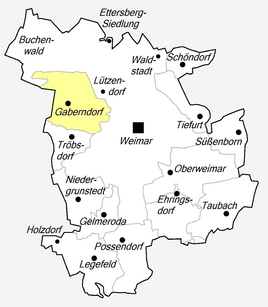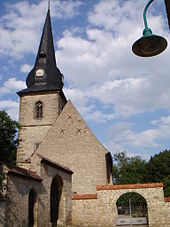Gaberndorf
|
Gaberndorf
City of Weimar
|
|
|---|---|
| Coordinates: 50 ° 59 ′ 44 ″ N , 11 ° 16 ′ 34 ″ E | |
| Height : | 274 (240-468) m above sea level NN |
| Area : | 5.04 km² |
| Residents : | 1570 (Dec. 31, 2010) |
| Population density : | 312 inhabitants / km² |
| Incorporation : | July 1, 1994 |
| Postal code : | 99428 |
| Area code : | 03643 |
|
Location of Gaberndorf in Weimar
|
|
|
View of Gaberndorf and the Ettersberg
|
|
Gaberndorf is a district of Weimar in Thuringia .
geography
Gaberndorf has a transport connection to Erfurt through the federal highway 7 . The settlement on Ettersberg arose because of the protective location provided by the slope and the fertile soil, as well as the presence of a small river. The district is bounded in the east by the city of Weimar (2 km), in the north by the Ettersberg with the Buchenwald memorial , in the west by the municipality of Daasdorf and in the south by the municipality of Tröbsdorf . The place receives the drinking water in the form of mixed water from the Ohratalsperre and the waterworks Tiefengruben. The mean local time is 14 minutes 40 seconds behind Central European Time .
Settlement typology
The classification according to village forms cannot be clearly made in Gaberndorf. On the one hand, a street leads through the "old village" with gabled houses on both sides (similar to a street village ). There is also a village ring with houses, the church and a fountain, which is reminiscent of a ring village or a round square village . At the upper end of this ring is the Anger , from which the first settlements down the slope arose some time ago (similar to an Anger village ).
With regard to different house forms, one can distinguish between “old village” and “new building area”. In the new development area there are mainly row houses and apartment buildings. In the original district you can usually find three-piers , as they are often found in Thuringia, but there are also a few four-piers . The number of these courtyards is divided equally into eaves and gables .
history
Early and Middle Ages
The first finds of flint tools, blades, scrapers , burins and arrowheads probably come from Mesolithic hordes of hunters from 10,000 years ago. 4000 BC The first Neolithic farmers and cattle breeders settled in the Rödelgraben. The finds from this period include stone axes , flint tools and grinding plates as well as “new technologies” in the form of saws, grinders and drills. From around 2000 BC. A Bronze Age burial ground was found in the east of the town center. However, this was destroyed by a quarry around 1890 . Due to these graves, an initial settlement during the Franconian period can be assumed. The area around the strongly flowing springs on the Oberteich is considered to be the core, further expansion took place during the Slav period down the slope on both sides of the brook to the church.
Gaberndorf was first mentioned in a document in 1291, and the church was also mentioned for the first time in 1333. After the Count's War in 1378, Weimar's “Red Book” listed all of the monasteries, towns and properties of the Weimar Office and determined their fiefs, labor and interest. Gaberndorf had to cope with high taxes in cash and in kind.
Modern times
In 1528 the Weimar area became Protestant. In 1546 Gaberndorf had 202 inhabitants and 45 houses. From 1600 there is an almost complete record of all schoolmasters in the Gaberndorfer school . In 1615 Gaberndorf already had 280 inhabitants and three years later the Thirty Years' War began , to which the inhabitants of this place also fell victim. In 1635 Gaberndorf was severely decimated by the plague. 129 people fell victim to her, 44 in October alone. In 1642 Gaberndorf only had 219 residents. In 1705 the church tower was renewed and got its present appearance.
On October 14, 1806, at six o'clock in the morning the cannon thunder of the battle of Jena could be heard and at ten o'clock the first Prussians were already fleeing through the town. In the evening, the inhabitants saved themselves to the top of the Ettersberg while the village was plundered by the French spoon guard. On September 6, 1808, the great hunt took place on the Ettersberg. Participants were Napoleon , Tsar Alexander, many kings and other high personalities. In 1847 the Weimar-Erfurt railway line was inaugurated in the immediate vicinity of the town. In 1890, according to contemporaries, the last thatched roofs disappeared. The residents could now be supplied with bricks from local production. The brick factory burned down completely when the Americans marched in.
In 1901 the Bismarck Tower was inaugurated on the Ettersberg. 17 Gaberndorfer never returned from the First World War (1914–1918). Then in 1922 a memorial for the victims of the war was erected next to the church. In 1932 elections took place in the village. The result was: 32% KPD, 35% SPD (no further information on remaining 33%). In 1937 the Buchenwald concentration camp was established on the Ettersberg. In 1939 Buchenwald prisoners built a water pipe on the east side of the village. Buchenwald prisoner detachments marched through the town every day.
Second World War
On August 24, 1944, Gaberndorf experienced the first bomb attack in the immediate vicinity of the Buchenwald concentration camp. On April 11, 1945, the first American tanks reached Gaberndorf around 3 p.m. The Buchenwald concentration camp was liberated on the same day and in the evening armed prisoners marched through the village. 58 Gaberndorf residents did not return home from the Second World War (1939–1945). In 1992 two memorial plaques for the victims of the war were installed next to that of the First World War.
Post-war until today
| Age group | people |
|---|---|
| under 7 years | 115 |
| 7 years to under 15 years | 92 |
| 15 years to under 25 years | 224 |
| 25 years to under 40 years | 332 |
| 40 years to under 65 years | 498 |
| 65 years and older | 286 |
The Soviet troops moved in until 1949 and Gaberndorf also became part of the GDR . The church was freed from the war damage. The population in May after the Bismarck Tower was blown up was 837. In 1956 the Buchenwald Memorial and the bell tower were built on the same site . In 1958, excavation work began to build a water pipe . Each man had to dig twelve meters. So it was managed to connect Gaberndorf to the Weimar water supply network by 1962. In 1960 Gaberndorfer founded the LPG "Am Ettersberg" (Type I). Twelve farms now cultivated 107 hectares of land. Six years later, on October 7th, “Republic Day”, the consumption was ceremoniously handed over. In 1973 new homes were built on the west side of the village. The Rödelgraben, which was decisive for a permanent settlement at the foot of the Ettersberg, was completely piped. Today only two small ponds and a fountain remind of him.
In 1975 the newly built kindergarten was inaugurated. Three years later, the Gaberndorf polytechnic school was closed after the reopening of the school in Niederzimmer and the pupils started school there. In the 1980s Gaberndorf received a sewer system piece by piece. After the borders were opened and Germany was reunified , more space was needed. In 1992 the place expanded continuously with the construction of a new settlement "Above the Village". In 1994 Gaberndorf was incorporated into Weimar, along with many other places. The population at that time was 586. After a sports field and other public facilities were created in the following years, the population continued to rise; In 2006 there were around 1547 inhabitants in Gaberndorf, 745 of whom were male and 806 female.
literature
- Local history of Gaberndorf (manuscript)
Web links
- Gaberndorf's website on the city of Weimar's website




